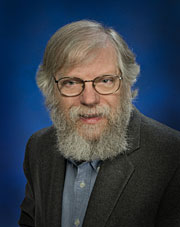- Number 342 |
- July 25, 2011
Brookhaven’s Pete Siddons: Studying Art with Science

Brookhaven Lab physicist
Pete Siddons
Brookhaven Lab physicist Pete Siddons, who shared a 2011 R&D 100 Award for developing instrumentation that will drastically speed up of the study of materials ranging from environmental samples to 17th-century paintings, has a scientific career that almost wasn’t.
In 1968, halfway through a degree in electrical engineering from the University of Bristol in the United Kingdom, Siddons “did what everyone else was doing in the late 60s and early 70s.”
He dropped out.
The aspiring scientist and guitarist left the university to pursue the latter career. But after returning to the school as a technician, Siddons’ boss set him back on the educational path by allowing him to work toward his master’s degree.
Siddons, who calls his return to the science field “serendipitous,” and credits his wife, Liz, for giving him much-needed encouragement, went on to receive his Ph.D. in physics from Kings College in 1979.
After a brief stint at Precision Electronic Components in Canada, Siddons joined Brookhaven’s National Synchrotron Light Source (NSLS) in 1985. He’s remained there ever since. Siddons first made his mark at NSLS by developing novel beamline optics, the systems of lenses and mirrors needed to focus and aim synchrotron light at the sample being studied. In 2000, his focus switched to detectors.
“I’ve always had an interest in detector development (YOUTUBE LINK),” said Siddons, who leads the detector R&D group that serves NSLS and its soon-to-be replacement, the National Synchrotron Light Source II (NSLS-II). “Many of the current photon and detector systems date back to the ‘70s, and upgrading them is the best way to provide better utilization in synchrotron facilities. The NSLS plays a leading role in promoting this kind of development.”
One of his latest projects, called the Maia x-ray microprobe detector system, won researchers from Brookhaven and the Commonwealth Scientific and Industrial Research Organisation in Australia an R&D 100 Award this year. The technique allows researchers to measure trace elements in samples 1,000 times faster than with previous methods, and has been used to image everything from soil deposits to barley grain, to paintings created by Bertha Lum, Edward Hopper, and Rembrandt.
“We’re using this high-tech tool that was developed for hard-core science to tell us something about humanity,” Siddons said.
The Maia detector also will be used in a number of beamlines at NSLS-II, now under construction, where x-rays 10,000 times brighter than those at NSLS will be produced.
This is his third R&D 100 Award; the first two were given in 1990 and 2006. Siddons, who has three children, also is a Fellow of the American Physical Society.
Submitted by DOE's Brookhaven National Laboratory
